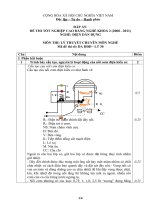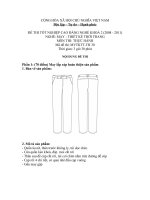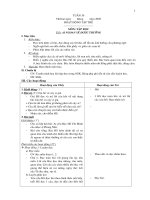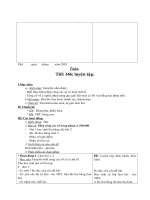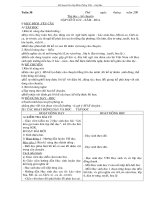PASSAGE 30
Bạn đang xem bản rút gọn của tài liệu. Xem và tải ngay bản đầy đủ của tài liệu tại đây (48.91 KB, 4 trang )
PASSAGE 30
Urbanization results in more, large cities. Lager cities create a new set of transportation sanitation and
infrastructure requirement and change the fundamental market dynamics for companies in wide variety of
industries. New technologies, process, products and engineering solutions are being created to address the
unique issues resulting from the unprecedented rate and scale of urbanization that is happening now.
The impact of urbanization falls into three primary categories. The first is infrastructure, as public
officials and city planners need to build infrastructure to support large populations in a sustainable
fashion, which private companies will ultimately build and manage. Second are private development
companies, which compete with their peers to build and manage large dwellings, venues and facilities that
people live, shop, eat and are entertained in. The third are consumer products companies that sell goods
and services to people whose consumption patterns are influence by where and how they live.
Urbanization in the United States coincides with a deep need to modernize city infrastructure. The
infrastructure for many American cities was created in the post-war era and has neared or surpassed its
planned lifespan. Additionally, this infrastructure often supports a large population than projected and
new technologies are available but have not yet been incorporated into infrastructure projects. We see
abundant evidence that cities across the United States are looking for solutions to these issues. Among
this evidence is the American Society of Civil Engineers, which scores United States infrastructure
broadly as a D+, starting the United States requires $3.6 trillion in needed investment by 2020.
Urban markets are different from suburban or rural markets for companies who build and sell goods and
services. This is not a new challenge and some companies have adapted better than others as this new
reality has started to take shape in recent years. However, the rate of change continues to increase and the
collision of more people and new types of infrastructure will impact markets and force companies to
continue to adapt. There will be companies that gain and lose market share resulting from the decisions
they make to prepare for shifting markets. There will also be companies that fail and new companies that
emerge resulting from shifting market dynamics.
Cities, urban planner and related public also face major challenge to accommodate sustainable growth
and incorporate new technological in an appropriate, cost-efficient and environmentally sustainable
fashion. Some cities will likely over-invest in the wrong technologies and design approaches. Others will
underestimate the scale of impending change and fail to plan accordingly resulting in deteriorating and
dangerous cities.
In summary, urbanization represents a structural change to the global system that both companies and
public institutions will spend money to plan for. Unlike some of our more early-stage themes,
urbanization is occurring now and will continue for the foreseeable future.
Question 1. Which title best reflects the main ideal of the passage?
A. Urbanization in large cities
B. Direct and Secondary Effects of Urbanization.
C. How does industrialization lead to Urbanization.
D. Urbanization in the United States.
Question 2. The word “that” in paragraph 2 refers to:________
A. consumer
B. products
C. companies
D. the third impact
Question 3. Which of the following is least likely to happen?
A. None of the companies will be acquainted with urban markets.
Page 1
B. The market share for each company will gradually become the same.
C. There will be an intense competition among companies who build and sell goods and services.
D. The United States will invest a huge amount of money in modernizing infrastructure.
Question 4. The words “surpassed” in paragraph 3 is closet in meaning to ________.
A. exceeded
B. reached
C. maximized
D. assured
Question 5. The author mentions American Society of Civil Engineer as an example to support which of
the following?
A. The United States doesn’t spend enough money on modernizing infrastructure.
B. Many projects failed to improve infrastructure to support megacities.
C. American Society of Civil Engineers is the only organization that possesses new technologies to
support infrastructure problems.
D. Cities in the US are finding ways to deal with infrastructure problems.
Question 6. The phrase “take shape” in paragraph 4 means_________
A. be completely dealt with
C. become worse
B. develop and become more complete or organized
D. have more influence
Question 7. It can be inferred from the passage that
A. Urbanization doesn’t happen in small cities
B. The cities development is accompanied by urbanization, which means companies don’t have to
make any changes to develop.
C. The basic system and services in cities will become better and better
D. Urbanization which is occurring now is a short-term problem.
Question 8. Where is this passage most likely seen in?
A. a college catalog
B. a business company brochure
C. a global development journal
D. a science journal
ĐÁP ÁN
1-B
2-C
3-B
6-B
7-C
8-C
4-A
5-D
LỜI GIẢI CHI TIẾT
Question 1:
Tiêu đề nào phản ánh đúng nhất ý tưởng chính của đoạn văn?
A. Đơ thị hóa ở các thành phố lớn
B. Tác động trực tiếp và thứ cấp của đơ thị hóa.
C. Cơng nghiệp hóa dẫn đến đơ thị hóa như thế nào.
D. Đơ thị hóa ở Hoa Kỳ.
=> Dẫn chứng: The impact of urbanization falls into three primary categories. The first is infrastructure,
as public officials and city planners need to build infrastructure to support large populations in a
sustainable fashion, which private companies will ultimately build and manage. Second are private
development companies, which compete with their peers to build and manage large dwellings, venues and
facilities that people live, shop, eat and are entertained in. The third are consumer products companies
Page 2
that sell goods and services to people whose consumption patterns are influence by where and how they
live.
Dịch: Tác động của đơ thị hóa rơi vào ba loại chính. Đầu tiên là cơ sở hạ tầng, vì các quan chức cơng
cộng và các nhà hoạch định thành phố cần xây dựng cơ sở hạ tầng để hỗ trợ dân số lớn một cách bền
vững, mà các công ty tư nhân cuối cùng sẽ xây dựng và quản lý. Thứ hai là các công ty phát triển tư nhân
cạnh tranh với các công ty cùng ngành để xây dựng và quản lý nhà ở, địa điểm và cơ sở lớn mà mọi người
sống, mua sắm, ăn uống và giải trí. Thứ ba là các công ty sản phẩm tiêu dùng bán hàng hóa và dịch vụ
cho những người có mơ hình tiêu dùng ảnh hưởng bởi nơi họ sống.
Question 2:
Từ “that” trong đoạn 2 nói đến: ___
A. người tiêu dùng
B. sản phẩm
C. công ty
D. tác động thứ ba
=> Dẫn chứng: The third are consumer products companies that sell goods and services to people whose
consumption patterns are influenced by where and how they live.
Dịch: Thứ ba là các công ty tiêu thụ sản phẩm, các cơng ty bán hàng hóa và dịch vụ cho những người có
mơ hình tiêu dùng bị ảnh hưởng bởi nơi họ sống.
Question 3:
Điều nào sau đây ít có khả năng xảy ra?
A. Không ai trong số các công ty sẽ làm quen với thị trường đô thị.
B. Thị trường của mỗi công ty sẽ dần trở nên giống nhau.
C. Sẽ có một cuộc cạnh tranh khốc liệt giữa các cơng ty xây dựng và bán hàng hóa và dịch vụ.
D. Hoa Kỳ sẽ đầu tư một số tiền rất lớn vào việc hiện đại hóa cơ sở hạ tầng.
=> Dẫn chứng: Urban markets are different from suburban or rural markets for companies who build and
sell goods and services.
Dịch: (D) Thị trường đô thị khác với thị trường ngoại thành hoặc nông thôn đối với các công ty xây dựng
và bán hàng hóa và dịch vụ.
Question 4:
Surpassed (vượt qua)= exceeded (Vượt quá)
Reached: đạt
Maximized: tối đa
Assured: đảm bảo
Question 5:
Tác giả đề cập đến Hiệp hội kỹ sư xây dựng Mỹ là một ví dụ để hỗ trợ điều nào sau đây?
A. Hoa Kỳ không dành nhiều tiền cho việc hiện đại hóa cơ sở hạ tầng.
B. Nhiều dự án thất bại trong việc cải thiện cơ sở hạ tầng để hỗ trợ các siêu đô thị.
C. Hiệp hội kỹ sư dân dụng Mỹ là tổ chức duy nhất sở hữu các công nghệ mới để hỗ trợ các vấn đề về cơ
sở hạ tầng.
D. Các thành phố ở Mỹ đang tìm cách giải quyết các vấn đề về cơ sở hạ tầng.
Page 3
=> Dẫn chứng: Additionally, this infrastructure often supports a large population than projected and new
technologies are available but have not yet been incorporated into infrastructure projects. We see
abundant evidence that cities across the United States are looking for solutions to these issues.
Dịch: Ngoài ra, cơ sở hạ tầng này thường hỗ trợ dân số lớn hơn dự kiến và các cơng nghệ mới có sẵn
nhưng chưa được tích hợp vào các dự án cơ sở hạ tầng. Chúng tôi thấy bằng chứng phong phú rằng các
thành phố trên khắp Hoa Kỳ đang tìm kiếm giải pháp cho những vấn đề này.
Question 6:
Cụm từ “take shape” trong đoạn 4 có nghĩa là ___
A. hoàn toàn bị xử lý
B. phát triển và trở nên hồn thiện hơn hoặc có tổ chức
C. trở nên tồi tệ hơn
D. có nhiều ảnh hưởng
=> Dẫn chứng: Urban markets are different from suburban or rural markets for companies who build and
sell goods and services. This is not a new challenge and some companies have adapted better than others
as this new reality has started to take shape in recent years.
Dịch: Thị trường đô thị khác với thị trường ngoại thành hoặc nông thôn cho các công ty xây dựng và bán
hàng hóa và dịch vụ. Đây khơng phải là một thách thức mới và một số công ty đã thích nghi tốt hơn
những cơng ty khác vì thực tế mới này đã bắt đầu hình thành trong những năm gần đây.
Question 7:
Có thể được suy ra được điều gì từ đoạn văn _____
A. Đơ thị hóa khơng xảy ra ở các thành phố nhỏ
B. Sự phát triển của các thành phố đi kèm với q trình đơ thị hóa, có nghĩa là các cơng ty don don phải
thực hiện bất kỳ thay đổi nào để phát triển.
C. Hệ thống và dịch vụ cơ bản tại các thành phố sẽ ngày càng tốt hơn
D. Đơ thị hóa đang xảy ra hiện nay là một vấn đề ngắn hạn.
Question 8:
Đoạn văn này có khả năng được nhìn thấy ở đâu?
A. một danh mục đại học
B. một tài liệu công ty kinh doanh
C. một tạp chí phát triển tồn cầu
D. một tạp chí khoa học
Page 4


